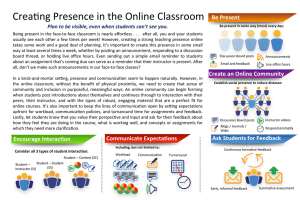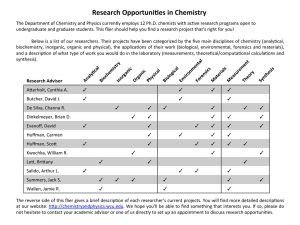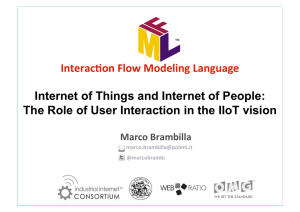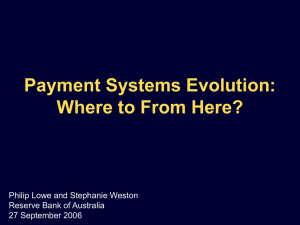Document 13839760
advertisement
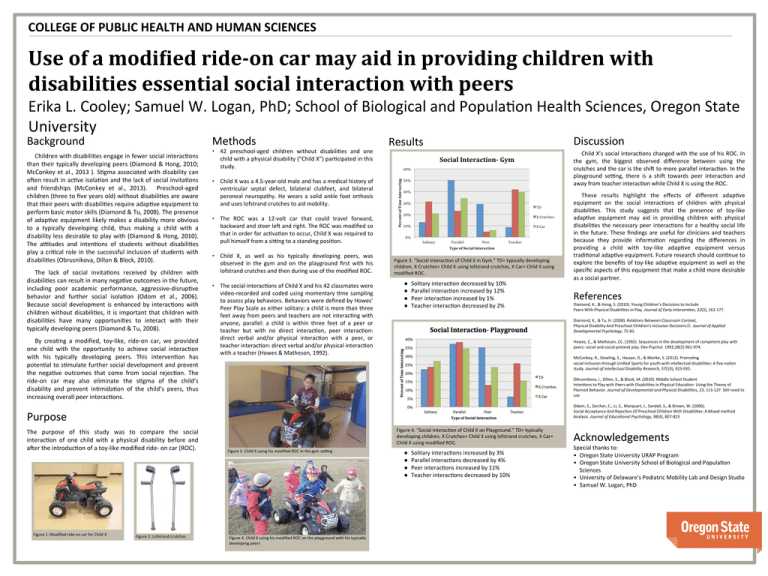
COLLEGE OF PUBLIC HEALTH AND HUMAN SCIENCES Use of a modi+ied ride-­‐on car may aid in providing children with disabilities essential social interaction with peers Erika L. Cooley; Samuel W. Logan, PhD; School of Biological and Popula?on Health Sciences, Oregon State University Background Methods Children with disabili?es engage in fewer social interac?ons than their typically developing peers (Diamond & Hong, 2010; McConkey et al., 2013 ). S?gma associated with disability can oOen result in ac?ve isola?on and the lack of social invita?ons and friendships (McConkey et al., 2013). Preschool-­‐aged children (three to five years old) without disabili?es are aware that their peers with disabili?es require adap?ve equipment to perform basic motor skills (Diamond & Tu, 2008). The presence of adap?ve equipment likely makes a disability more obvious to a typically developing child, thus making a child with a disability less desirable to play with (Diamond & Hong, 2010). The aUtudes and inten?ons of students without disabili?es play a cri?cal role in the successful inclusion of students with disabili?es (Obrusnikova, Dillon & Block, 2010). The lack of social invita?ons received by children with disabili?es can result in many nega?ve outcomes in the future, including poor academic performance, aggressive-­‐disrup?ve behavior and further social isola?on (Odom et al., 2006). Because social development is enhanced by interac?ons with children without disabili?es, it is important that children with disabili?es have many opportuni?es to interact with their typically developing peers (Diamond & Tu, 2008). By crea?ng a modified, toy-­‐like, ride-­‐on car, we provided one child with the opportunity to achieve social interac?on with his typically developing peers. This interven?on has poten?al to s?mulate further social development and prevent the nega?ve outcomes that come from social rejec?on. The ride-­‐on car may also eliminate the s?gma of the child’s disability and prevent in?mida?on of the child’s peers, thus increasing overall peer interac?ons. • 42 preschool-­‐aged children without disabili?es and one child with a physical disability (“Child X”) par?cipated in this study. • Child X was a 4.5-­‐year-­‐old male and has a medical history of ventricular septal defect, bilateral clubfeet, and bilateral peroneal neuropathy. He wears a solid ankle foot orthosis and uses lofstrand crutches to aid mobility. • The ROC was a 12-­‐volt car that could travel forward, backward and steer leO and right. The ROC was modified so that in order for ac?va?on to occur, Child X was required to pull himself from a siUng to a standing posi?on. • Child X, as well as his typically developing peers, was observed in the gym and on the playground first with his lofstrand crutches and then during use of the modified ROC. • The social interac?ons of Child X and his 42 classmates were video-­‐recorded and coded using momentary ?me sampling to assess play behaviors. Behaviors were defined by Howes’ Peer Play Scale as either solitary: a child is more than three feet away from peers and teachers are not interac?ng with anyone, parallel: a child is within three feet of a peer or teacher but with no direct interac?on, peer interac?on: direct verbal and/or physical interac?on with a peer, or teacher interac?on: direct verbal and/or physical interac?on with a teacher (Howes & Matheson, 1992). Results Discussion Child X’s social interac?ons changed with the use of his ROC. In the gym, the biggest observed difference between using the crutches and the car is the shiO to more parallel interac?on. In the playground seUng, there is a shiO towards peer interac?on and away from teacher interac?on while Child X is using the ROC. Figure 3. “Social Interac?on of Child X in Gym.” TD= typically developing children, X Crutches= Child X using lofstrand crutches, X Car= Child X using modified ROC. v ● ● ● ● Solitary interac?on decreased by 10% Parallel interac?on increased by 12% Peer interac?on increased by 1% Teacher interac?on decreased by 2% Purpose These results highlight the effects of different adap?ve equipment on the social interac?ons of children with physical disabili?es. This study suggests that the presence of toy-­‐like adap?ve equipment may aid in providing children with physical disabili?es the necessary peer interac?ons for a healthy social life in the future. These findings are useful for clinicians and teachers because they provide informa?on regarding the differences in providing a child with toy-­‐like adap?ve equipment versus tradi?onal adap?ve equipment. Future research should con?nue to explore the benefits of toy-­‐like adap?ve equipment as well as the specific aspects of this equipment that make a child more desirable as a social partner. References Diamond, K., & Hong, S. (2010). Young Children’s Decisions to Include Peers With Physical Disabili?es in Play. Journal of Early Interven0on, 32(3), 163-­‐177. Diamond, K., & Tu, H. (2008). Rela?ons Between Classroom Context, Physical Disability And Preschool Children's Inclusion Decisions☆. Journal of Applied Developmental Psychology, 75-­‐81. Howes, C., & Matheson, CC. (1992). Sequences in the development of competent play with peers: social and social pretend play. Dev Psychol. 1992;28(5):961-­‐974. McConkey, R., Dowling, S., Hassan, D., & Menke, S. (2012). Promo?ng social inclusion through Unified Sports for youth with intellectual disabili?es: A five-­‐na?on study. Journal of Intellectual Disability Research, 57(10), 923-­‐935. Obrusnikova, I., Dillon, S., & Block, M. (2010). Middle School Student Inten?ons to Play with Peers with Disabili?es in Physical Educa?on: Using the Theory of Planned Behavior. Journal of Developmental and Physical Disabili0es, 23, 113-­‐127. S?ll need to use Odom, S., Zercher, C., Li, S., Marquart, J., Sandall, S., & Brown, W. (2006). Social Acceptance And Rejec?on Of Preschool Children With Disabili?es: A Mixed-­‐method Analysis. Journal of Educa0onal Psychology, 98(4), 807-­‐823 The purpose of this study was to compare the social interac?on of one child with a physical disability before and aOer the introduc?on of a toy-­‐like modified ride-­‐ on car (ROC). Figure 4. “Social Interac?on of Child X on Playground.” TD= typically developing children, X Crutches= Child X using lofstrand crutches, X Car= Child X using modified ROC. Figure 3. Child X using his modified ROC in the gym seUng ● ● ● ● Solitary interac?ons increased by 3% Parallel interac?ons decreased by 4% Peer interac?ons increased by 11% Teacher interac?ons decreased by 10% Acknowledgements Special thanks to: • Oregon State University URAP Program • Oregon State University School of Biological and Popula?on Sciences • University of Delaware’s Pediatric Mobility Lab and Design Studio • Samuel W. Logan, PhD Figure 1: Modified ride-­‐on car for Child X Figure 2: Lofstrand crutches Figure 4. Child X using his modified ROC on the playground with his typically developing peers

